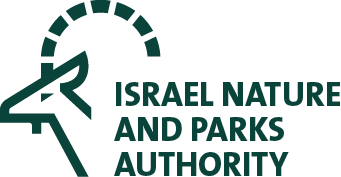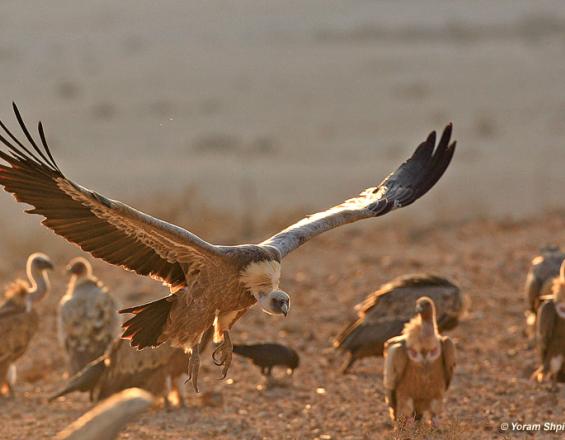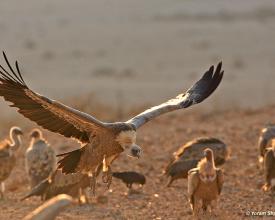
An innovative automatic location-based real-time alert system to prevent wildlife poisoning using GPS-tagged Griffon vultures has led to better conservation of endangered species in protected areas

Illegal poisoning by disgruntled farmers aiming to kill jackals that damage crops and livestock is a major threat to wildlife. Poisoned baits are put in carcasses leading to large-scale poisoning events that damage the entire ecosystem.
To aid in early detection we innovated an alert system which does automatic analysis in real-time of vultures' location, altitude, body temperature and speed from their GPS-tags. It then does poisoning-likelihood determination whenever the GPS data show behavior consistent with a vulture descending on a carcass. It then does geo-referencing in poisoning-prone zones and then sends automated Telegram alerts only to relevant regional ranger with exact location. All this in a few seconds, enabling rapid on-the-ground response, preventing potential poisonings.
To the best of our knowledge, this the only real-time automatic alert system for finding carcasses based on tagged scavengers operating successfully in the field.
Context
Challenges addressed
Illegal poisoning of wildlife is a major threat throughout the world. A major challenge is rapid detection of baits. Bulgaria and Israel independently thought of using vultures' data to detect carcasses. We solved the challenges of fast interpretation of GPS data to determine likelihood of a carcass, and then how to get a ranger there. Our advanced and automated system solves the trade-off between the need for fast response vs limited ranger time, by reducing false alarms and alerting only relevant rangers. It also has built-in oversight to record all alerts and responses for follow-up. In addition, collection of carcasses reduces food available for scavengers and effectively reduces the population without culling.
We bought special 4X4 trucks with winch hooks to remove carcasses from the field and take them to designated disposal facilities.
The system takes the wild animal's natural behavior and through a series of technological steps, transforms it into a successful method to protect the ecosystem.
Location
Process
Summary of the process
The 6 building blocks are listed as stages in the full system.
The vultures are tagged and their data goes continually and automatically in real-time to the system, where the algorithms determine if the behavioral data indicate likelihood for a carcass. If so, the system sends out an alert to the approriate ranger and the ranger responds. Once on-site the ranger has to follow protocol for removal of carcass and if needed handling the poisong event. At the end the supervisor gets a report of all alerts sent and the responses.
Building Blocks
GPS-Tagged vultures send out data
In order to receive GPS data there have to be a requisite numner of birds with approriate tags that transmit real-time data.
Enabling factors
- experienced staff to capture and tag vultures
- financial backing to purchase tags and the data
Lesson learned
The more tagged birds there are, the wider the coverage and the better the success.
Advanced loggers receive GPS data
- Integration of data on position, altitude, speed, and temperature from Orintela transmitters with the INPA information system
Enabling factors
- IT professionals and developers
- input from Ornitela
Lesson learned
Input from transmitter manufacturer helps to integrate with home systems.
Algorithms for likelihood of carcass and need for alert
Specific algorithms process the GPS data on position, altitude, speed and temperature and consider all zonation as poisoning-prone areas (based on land use for grazing and previous events) to determine if alert is necessary.
Algorithms need to rule out vulture descending onto a cliff or nest, and to include only descent onto areas where carcass likelihood is highest (based on ground inclination).
Algorithm calculates slope of the land at point of descent and adds this to the poisoning likelihood determination.
Enabling factors
- need excellent detailed GIS data of ground features and topography
- need lots of data of previous poisoning events
- need data on land use (for rangeland or crops)
Lesson learned
- High resolution topgraphy layers are very important to rule out vultures landing on unlikely sites
System links to Telegram app for sending alerts to relevant rangers
After the algorithms determine that an alert is needed, it sends out an alert only to nearby on-call rangers via the Telegram app on their smartphones.
Enabling factors
- integration of alert system with real-time ranger position and ranger's on-call status (active or off-duty)
- integration with Telegram system
- Integration with Waze or other GPS-based driving solution app
Lesson learned
Telegram is best for sending alerts.
Focusing alerts nly to relevent rangers reduces unnecessary false alarms and improves effcieny of real responses.
Rangers remove the carcass and deal with poisoning
- Once the ranger arrives on site, he has to prepare to remove the carcass from the field usually by calling for the INPA field truck.
- If there are injured animals on site these have to receive first-aid and veterinary care quickly.
- If the carcass is laced with poison it has be secured to prevent access by more animals.
- The site has be searched for more animals further away.
- The entire site has to be treated also as a crime scene so investigative and forensic evidence is maintained and then collected carefully.
Enabling factors
- Proper training or protocols for dealing with poisoning events
- Proper radio or telephone system for all areas.
- Tractor or 4X4 vehicle capable of removing animal carcass from the field
- Veterinarians on-call in all areas to receive poisoned animals
Lesson learned
Important to have proper training and practive of protocols for dealing with poisoning events.
Impacts
Illegal poisoning has caused decline of critically endangered Griffon vultures in recent years. As an important scavenger, preventing their poisoning supports crucial ecosystem services and improves environmental health for wildlife and people, too.
Poisoned carcasses harm not only the tagged Griffon vultures but also other threatened species. So, our system has had a very wide positive effect in reducing poisoning events, directly and indirectly through the food chain.
The alert system enables fast on-the-ground response and carcass removal. Even when not laced with poison, transferring carcasses from the field to vulture feeding stations reduces food availability to overabundant jackals, reducing their carrying capacity and population size without lethal culling. Reducing jackals lowers human-wildlife conflict and greatly cuts costs of depredation and crop damage. Vultures get the caracasses at controlled sites.
This project is a nature-based solution in a literal sense; enabling better management of protected areas based on animals' own behavioral data.
Beneficiaries
- Threatened and protected species of wildlife
- Farmers – reduction of human-wildlife conflict
- Nature-based solution
- Human health- sanitation (removal of carcasses)
Sustainable Development Goals
Story
It was at first light, just after 5 o'clock in the morning, on 9 May 2019 when INPA ranger Uria Vazana was suddenly awoken from a deep sleep by a shrill call coming from his smartphone. This wasn't the phone's usual ring, and it took his sleep-foggy mind a few seconds to realize what it was. It was an alert from the automatic vulture detection program telling him that a Griffon vulture fitted with a GPS-tag has descended from the sky nearby in a way that the algorithm has interpreted to mean that it has come down from the sky onto a carcass.
This certainly wasn't the first time he'd gotten such an alert, so he had already learned that the system works really well. When it sends out an alert, there is almost always a fresh carcass that some vulture had found.
On this particular morning Uria grabbed a cup of coffee and jumped into his jeep with his trusted dog as companion. He switched on the headlights and quickly took off into the early dawn to the GIS location in the central Golan Heights in northern Israel, to the spot designated on his smartphone by the system.
No sooner had he arrived then he immediately realized it wasn't just a dead cow on the site but far worse; here were the first-signs of a deliberate poisoning event! Switching into fast-action mode he immediately located 8 poisoned vultures on the ground that were still alive. He quickly called for back-up and immediately began the protocol for handling a mass-poisoning event.
On that morning, Uria and the other rangers who arrived, raced with all the poisoned vultures to get emergency veterinary care, but only 2 survived. Uria was sad that he couldn't save them all but he knows without a doubt, that the GPS alert system and his rapid response, definitely prevented a scene far-worse than the one he found.
Further searches of the area over the next few days showed only a very few animals, and this was mainly due to the fast response by the ranger. Two poisoned jackals and one striped hyena was far fewer than can occur from a poisoned carcass where sometimes there are dozens or even hundreds of dead animals.
Since then, the 2 vultures that he saved have been returned to the wild, and they now have GPS tags on them, and they too are contributing data to the system to help save other wildlife.





